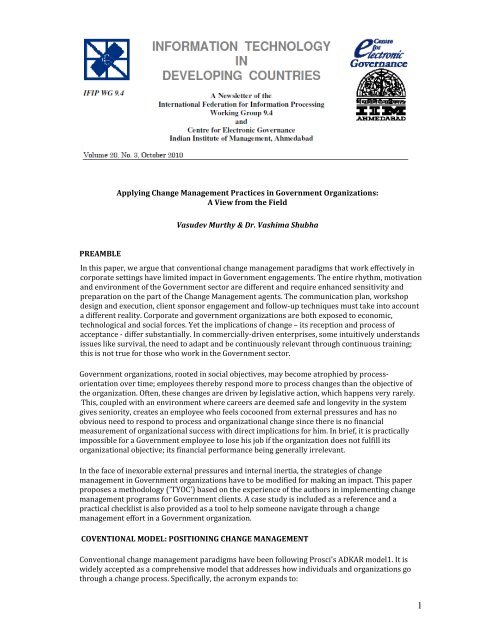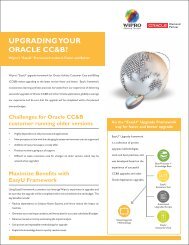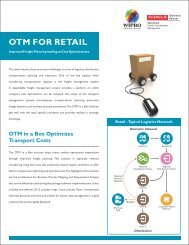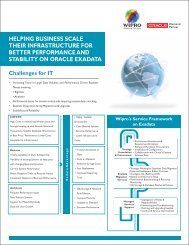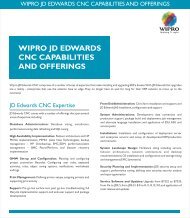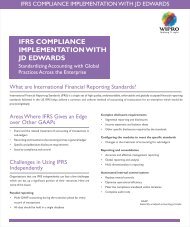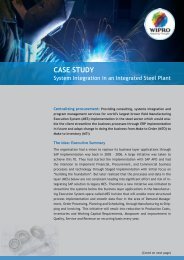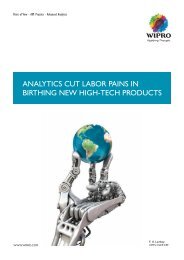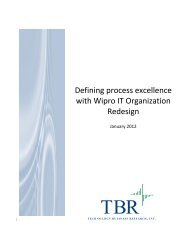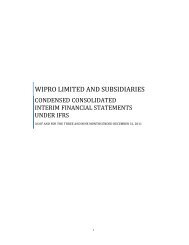Applying Change Management Practices in Government - Wipro
Applying Change Management Practices in Government - Wipro
Applying Change Management Practices in Government - Wipro
Create successful ePaper yourself
Turn your PDF publications into a flip-book with our unique Google optimized e-Paper software.
PREAMBLE<br />
<strong>Apply<strong>in</strong>g</strong> <strong>Change</strong> <strong>Management</strong> <strong>Practices</strong> <strong>in</strong> <strong>Government</strong> Organizations:<br />
A View from the Field<br />
Vasudev Murthy & Dr. Vashima Shubha<br />
In this paper, we argue that conventional change management paradigms that work effectively <strong>in</strong><br />
corporate sett<strong>in</strong>gs have limited impact <strong>in</strong> <strong>Government</strong> engagements. The entire rhythm, motivation<br />
and environment of the <strong>Government</strong> sector are different and require enhanced sensitivity and<br />
preparation on the part of the <strong>Change</strong> <strong>Management</strong> agents. The communication plan, workshop<br />
design and execution, client sponsor engagement and follow-up techniques must take <strong>in</strong>to account<br />
a different reality. Corporate and government organizations are both exposed to economic,<br />
technological and social forces. Yet the implications of change – its reception and process of<br />
acceptance - differ substantially. In commercially-driven enterprises, some <strong>in</strong>tuitively understands<br />
issues like survival, the need to adapt and be cont<strong>in</strong>uously relevant through cont<strong>in</strong>uous tra<strong>in</strong><strong>in</strong>g;<br />
this is not true for those who work <strong>in</strong> the <strong>Government</strong> sector.<br />
<strong>Government</strong> organizations, rooted <strong>in</strong> social objectives, may become atrophied by processorientation<br />
over time; employees thereby respond more to process changes than the objective of<br />
the organization. Often, these changes are driven by legislative action, which happens very rarely.<br />
This, coupled with an environment where careers are deemed safe and longevity <strong>in</strong> the system<br />
gives seniority, creates an employee who feels cocooned from external pressures and has no<br />
obvious need to respond to process and organizational change s<strong>in</strong>ce there is no f<strong>in</strong>ancial<br />
measurement of organizational success with direct implications for him. In brief, it is practically<br />
impossible for a <strong>Government</strong> employee to lose his job if the organization does not fulfill its<br />
organizational objective; its f<strong>in</strong>ancial performance be<strong>in</strong>g generally irrelevant.<br />
In the face of <strong>in</strong>exorable external pressures and <strong>in</strong>ternal <strong>in</strong>ertia, the strategies of change<br />
management <strong>in</strong> <strong>Government</strong> organizations have to be modified for mak<strong>in</strong>g an impact. This paper<br />
proposes a methodology ('TYOC') based on the experience of the authors <strong>in</strong> implement<strong>in</strong>g change<br />
management programs for <strong>Government</strong> clients. A case study is <strong>in</strong>cluded as a reference and a<br />
practical checklist is also provided as a tool to help someone navigate through a change<br />
management effort <strong>in</strong> a <strong>Government</strong> organization.<br />
COVENTIONAL MODEL: POSITIONING CHANGE MANAGEMENT<br />
Conventional change management paradigms have been follow<strong>in</strong>g Prosci's ADKAR model1. It is<br />
widely accepted as a comprehensive model that addresses how <strong>in</strong>dividuals and organizations go<br />
through a change process. Specifically, the acronym expands to:<br />
1
• Awareness - Why is this change necessary?<br />
• Desire - What motivates a person to desire change?<br />
• Knowledge - Now that motivation exists, what specifically needs to be done?<br />
• Ability – Know<strong>in</strong>g what needs to be done, how should this knowledge be applied<br />
• Re<strong>in</strong>forcement - Once is not enough - repeated application of this knowledge is necessary<br />
for susta<strong>in</strong><strong>in</strong>g change.<br />
The well-known change management curve takes the ADKAR model <strong>in</strong>to the realm of visual<br />
understand<strong>in</strong>g and addresses emotional aspects. From the <strong>in</strong>itial shock that comes with<br />
awareness of an impend<strong>in</strong>g change, a person (and by extension a large group) retreats <strong>in</strong>to denial<br />
(that this announced change isn't necessary at all). As the awareness and sensitization process<br />
gathers steam and ga<strong>in</strong>s support via <strong>in</strong>ternal campaigns and communications, a person f<strong>in</strong>ally<br />
reconciles with the <strong>in</strong>evitable, either as an enthusiastic participant or as part of a larger group<br />
that goes with the flow, acquir<strong>in</strong>g the new skills needed to cope with the change. The f<strong>in</strong>al<br />
positive upsw<strong>in</strong>g <strong>in</strong> emotions would witness experiment<strong>in</strong>g with ideas, search<strong>in</strong>g for a degree of<br />
comfort and f<strong>in</strong>ally fully <strong>in</strong>tegrat<strong>in</strong>g with the new reality.<br />
Figure 1: The <strong>Change</strong> Curve<br />
Along the way, Brand<strong>in</strong>g, communication strategies such as <strong>in</strong>ternal newsletters, workshops,<br />
identification of enthusiastic acceptors and active resistors and celebration of important<br />
transition<strong>in</strong>g milestones are part of the whole change management strategy. Given that the vast<br />
majority of consult<strong>in</strong>g engagements <strong>in</strong>volve changes of some k<strong>in</strong>d, it is unwise to dive <strong>in</strong> without<br />
giv<strong>in</strong>g thought to the change management process. <strong>Change</strong> <strong>Management</strong> is not a nice, optional,<br />
feel-good layer; it should be a tangible thread through every s<strong>in</strong>gle consult<strong>in</strong>g <strong>in</strong>tervention. If<br />
carried out with persistence by the change management team and with senior management<br />
support, most change management <strong>in</strong>itiatives have every chance of success; we call this the<br />
Power of Two.<br />
2
Figure 2: The Power of Two<br />
And <strong>in</strong>deed, s<strong>in</strong>ce there is a universal ethos today where employees understand that a company<br />
needs to be profitable and competitive to survive, programs that cleverly <strong>in</strong>tegrate change<br />
management <strong>in</strong>itiatives are likely to succeed. In The Bus<strong>in</strong>ess Impact of <strong>Change</strong> <strong>Management</strong>2 by<br />
Petouhoff, Chandler and Montag-Schmaltz published <strong>in</strong> the Pepperd<strong>in</strong>eUniversity's Graziado<br />
Bus<strong>in</strong>ess Review, we f<strong>in</strong>d compell<strong>in</strong>g referenced data: an ROI of 143% where an OCM<br />
programwas <strong>in</strong> place and a mere 35% where an OCM program was not <strong>in</strong> place. This and other<br />
studies are directed at commercial enterprises, where the constituents are sensitized, at a deep<br />
level, that constant change is a fact of everyday life. For such constituents, communications about<br />
organizational structural changes, strategic directional changes, workforce reduction or<br />
enhancement via acquisition, technology <strong>in</strong>frastructure alterations and so on are endemic.<br />
GAPS IDENTIFIED: NEED FOR A GOVERNMENT-ORIENTED MODEL<br />
Our description so far has been relevant to the corporate world. How different is it <strong>in</strong> the<br />
<strong>Government</strong> Organization?<br />
<strong>Change</strong> <strong>in</strong> the <strong>Government</strong> follows different dynamics. By implication, government organizations<br />
work towards fulfill<strong>in</strong>g a social purpose. This can range from law enforcement, military<br />
preparedness to visible citizen services like licenses, permits and social security; tax revenues are<br />
gathered and dispensed to provide services to a citizen. There is a sublim<strong>in</strong>al patriotic theme to<br />
such services - a citizen's emotive need for social association is addressed if he feels that his taxes<br />
are com<strong>in</strong>g back to him <strong>in</strong> the form of certa<strong>in</strong> basic services that enable him to be effective <strong>in</strong><br />
society.<br />
In do<strong>in</strong>g so, government organizations are often driven by legislative authority and have clearly<br />
def<strong>in</strong>ed boundaries with<strong>in</strong> which they operate. Like corporate entities, they too have to be<br />
process-oriented <strong>in</strong> order to deliver.<br />
Figure 3: The Context of a <strong>Government</strong> Employee<br />
But the similarity ends there. A corporate employee who has been programmed over global, national<br />
and sectoral economic cycles to "change-with-the-times", government employees are buffered, or<br />
presume they are, as discussed earlier. Thus the approach to achieve the desired impact through the<br />
<strong>in</strong>troduced change needs to be different. This is a particularly sensitive task when the change<br />
consultant has been brought from the corporate world and a cultural clash is possible - the tra<strong>in</strong>er is<br />
likely to come across as overconfident, lack<strong>in</strong>g knowledge of their sensitivities and context.<br />
3
A CASE STUDY<br />
The historical charter of this organization was offer<strong>in</strong>g social security and health services to a<br />
specific category of beneficiaries. It was a department with a social objective with an extended<br />
customer base stretch<strong>in</strong>g to 50 million citizens; the organization had a long history, which was<br />
managed by career bureaucrats and had a legally mandated mission.<br />
This department was fac<strong>in</strong>g tremendous challenges <strong>in</strong> achiev<strong>in</strong>g transparent and efficient process <strong>in</strong><br />
delivery of citizen service; compla<strong>in</strong>ts of poor customer service, procedural delays and rigidity were<br />
common. An IT solution was adopted by this Department to meet the need for speed, transparency<br />
and accuracy. The IT revolution brought functional changes which impacted employees both at the<br />
personal and the organizational levels.<br />
As the department focused on f<strong>in</strong>d<strong>in</strong>g and implement<strong>in</strong>g the solutions best suited to their needs,<br />
deployment, <strong>in</strong>tegration, <strong>in</strong>frastructure issues became a priority over and above the pressure created<br />
on the employee who had to learn and adapt to the new ethos. From an employee's standpo<strong>in</strong>t there<br />
were several reasons to be resistant to this change. One, In <strong>Government</strong> setups, the schemes or the<br />
projects are mandated at either the federal or the central level and these decision makers are<br />
generally away from the day- to -day function<strong>in</strong>g of the employee. As a consequence, this became the<br />
first po<strong>in</strong>t of resistance, where the senior management at the state level did not approve of the<br />
scheme.<br />
The middle management was <strong>in</strong>formed of the approach<strong>in</strong>g change through a circular or notice ask<strong>in</strong>g<br />
them to do the needful, hence lack<strong>in</strong>g the clarity of action /purpose thereby creat<strong>in</strong>g the second layer<br />
of resistance. Three, the <strong>in</strong>formation spread further down the ranks <strong>in</strong> a diluted and unspecified<br />
manner over-the-tea sessions and the ‘afternoon walk discussions which created the image of change<br />
as an impend<strong>in</strong>g threat to the employees function and job security. The third po<strong>in</strong>t of resistance<br />
was most complicated and the employees were backed by a strong union and <strong>in</strong>terest groups. A<br />
situation was created where the project was also challenged.<br />
The organization's executive board decided that the best way to tackle resistance was to roll out a<br />
comprehensive change management <strong>in</strong>tervention program. The roll-out was delivered by a dedicated<br />
team of facilitators and <strong>Change</strong> <strong>Management</strong> experts from <strong>Wipro</strong> Consult<strong>in</strong>g Services (WCS) To lend<br />
a positive, non threaten<strong>in</strong>g image to the workshops WCS designed and created a forum called<br />
'Element’ - A Forum for Leaders and Mentors. This helped <strong>in</strong> address<strong>in</strong>g employee resistance as<br />
they felt <strong>in</strong>volved <strong>in</strong> the change. The outcomes of the workshops were frequently shared with the<br />
organization's senior management. An effective knowledge shar<strong>in</strong>g tool was put <strong>in</strong> place to be a<br />
responsive and pro-active system to <strong>in</strong>tegrate the action plan emerg<strong>in</strong>g from the workshops. In<br />
summary, the participants -<br />
- recognized the importance and essential role that New IT Project plays <strong>in</strong> the development and<br />
reforms <strong>in</strong> service delivery<br />
- recognized the importance of align<strong>in</strong>g government orders and policies <strong>in</strong> the <strong>in</strong>tegration process<br />
- appreciated the need to make the details of the new IT Project better known to external employers<br />
and workers who subscribed to the organization's mission<br />
Dur<strong>in</strong>g the workshops a pre- and post-stakeholder diagnostic study was conducted through<br />
structured questionnaires. The objective was to assess the change <strong>in</strong> levels of project awareness,<br />
project preparedness, and no fear of technology and most significantly, change <strong>in</strong> attitude. The<br />
overall analysis at the end <strong>in</strong>dicates that those <strong>in</strong>volved <strong>in</strong> the project not only knew more about<br />
what the project is, the importance of it, but they were able to see the significance of their role <strong>in</strong> it,<br />
and were better prepared for the change to come. By the end of the change management workshops,<br />
the overall progress was as follows:<br />
4
Source: <strong>Wipro</strong> Consult<strong>in</strong>g Services, <strong>Change</strong> <strong>Management</strong> Report, 2010<br />
In all, 600 officers from the Department were direct participants of the change management<br />
workshops and another 7000 through the ripple effect created by these change ambassadors. These<br />
changes were possible only because the leadership at the implement<strong>in</strong>g agency <strong>Wipro</strong>, and the client<br />
were committed to the successful rollout of the project and believed <strong>in</strong> the change management<br />
<strong>in</strong>tervention as a critical component of their strategy.<br />
Our experience also shows that <strong>in</strong> deal<strong>in</strong>g with change, the strategy must take <strong>in</strong>to account the fact<br />
that leadership styles are different <strong>in</strong> the corporate world and <strong>in</strong> the <strong>Government</strong>.<br />
In <strong>Government</strong> organizations, hierarchies are well def<strong>in</strong>ed and adm<strong>in</strong>istrative system is designed<br />
to give power to a person of seniority <strong>in</strong> tenure, irrespective of the <strong>in</strong>dividual’s capability to lead.<br />
For manag<strong>in</strong>g change, the sensitization of the person <strong>in</strong> power and his critical role to lead outside<br />
his normative leadership function is very important. In the face of change some situational<br />
leaders 3 may arise but most will rely on <strong>Government</strong> mechanisms of issu<strong>in</strong>g orders, conduct<br />
meet<strong>in</strong>gs and arrange tra<strong>in</strong><strong>in</strong>g programs for the employees undergo<strong>in</strong>g a process change.<br />
More often than not, even this <strong>in</strong>dividual may be unaware of the perturbations that may affect his<br />
organization. The change management exercise has to be designed to prepare the senior<br />
management to anticipate and lead by keep<strong>in</strong>g an eye on apparently all m<strong>in</strong>or events <strong>in</strong> the<br />
external environment and understand the effect of those events on their organization. A new<br />
law, economic changes, a new competitor, an unusual technology -the slightest blip could have<br />
massive implications. If the rate of change with<strong>in</strong> an organization is faster than the rate of change<br />
outside, the organization will survive and thrive. A complacent 'settled' organization that is<br />
conv<strong>in</strong>ced of its permanence will die.<br />
The theory of the ‘butterfly effect 4 ’ can be used to illustrate the astonish<strong>in</strong>g effect that a s<strong>in</strong>gle -<br />
almost <strong>in</strong>consequential - act could have on the larger system. Formally, the butterfly effect is a<br />
metaphor that tries to show how a s<strong>in</strong>gle t<strong>in</strong>y event - say the flapp<strong>in</strong>g of a butterfly's w<strong>in</strong>gs -<br />
could have an astonish<strong>in</strong>g effect on a larger system - say the creation of a tropical storm or<br />
cyclone. A sense of paranoia - watch<strong>in</strong>g for the flapp<strong>in</strong>g of the smallest metaphorical butterfly - is<br />
essential <strong>in</strong> a leader, for he then works to adapt and morph, not allow<strong>in</strong>g for even a moment's<br />
complacence.<br />
In our context then, change management should not be considered as a s<strong>in</strong>gle project with a<br />
def<strong>in</strong>ed start and end, but as a cont<strong>in</strong>uous strategic imperative.<br />
5
THE PROPOSED MODEL<br />
The proposed TYOC methodology of implement<strong>in</strong>g change management practices <strong>in</strong> the<br />
<strong>Government</strong> sector is based on the distilled experience of the authors personally runn<strong>in</strong>g many<br />
<strong>in</strong>itiatives.<br />
Trac<strong>in</strong>g<br />
We found that tapp<strong>in</strong>g organizational history and evok<strong>in</strong>g pride <strong>in</strong> it can be a powerful and<br />
compell<strong>in</strong>g force to propel a group towards the change objective. People seek mean<strong>in</strong>g <strong>in</strong> their<br />
careers and a sense of association and acceptance and these symbols provide structure and<br />
context. The consultant must identify the basis for the organization's existence and events that<br />
the organization has immortalized via stories and symbols. Demonstrat<strong>in</strong>g this critical<br />
knowledge will help the consultant come across as an <strong>in</strong>sider and not a corporate <strong>in</strong>terloper. We<br />
call this exercise "The TRACING" of Organizational History".<br />
Be<strong>in</strong>g knowledgeable about the follow<strong>in</strong>g aspects are critical <strong>in</strong> connect<strong>in</strong>g with the constituents<br />
• People – who mattered and figured <strong>in</strong> organizational folklore.<br />
• Events – acts of the legislature that created the organization's territory, and other<br />
def<strong>in</strong><strong>in</strong>g events <strong>in</strong>clud<strong>in</strong>g first office-bearers, MoUs, groundbreak<strong>in</strong>g research, the first<br />
office and so on.<br />
• Recognition – Organizational and <strong>in</strong>dividual recognition by others <strong>in</strong> the press, external<br />
entities and so on. This is particularly useful because a provocative question that can be<br />
asked dur<strong>in</strong>g <strong>in</strong>troduction rounds at workshops - "What has been your significant<br />
contribution to the organization?” This triggers a renewed sense of positive association<br />
and sets the tone for participation dur<strong>in</strong>g the workshop and thereafter.<br />
• Pioneers – identify prior direction-chang<strong>in</strong>g and path-break<strong>in</strong>g events from the past;<br />
there usually are, and <strong>in</strong>congruously, employees are usually proud of them. The po<strong>in</strong>t is<br />
to underl<strong>in</strong>e that "this organization is not foreign to change"<br />
After sett<strong>in</strong>g the context and creat<strong>in</strong>g an atmosphere of confidence and pride, you have to move<br />
on to the reason for change. Fail<strong>in</strong>g to execute this step will make the whole exercise alien and<br />
will cause a sense of resentment. Patience is the key.<br />
Y<br />
Tak<strong>in</strong>g some literary license here, the 'Y' stage <strong>in</strong>volves the articulation of the reason for change.<br />
The consultants must not spell out and <strong>in</strong>troduce the drivers for change. But she should have the<br />
checklist of the changes that she hopes that the group should come out with; this is usually done<br />
<strong>in</strong> prior consultation with the executive sponsors who have called for assistance. The executive<br />
sponsor must clearly spell out to the consultant what he is look<strong>in</strong>g for, but the consultant, as a<br />
master facilitator, must use tools and techniques to elicit precisely those drivers for change. A<br />
typical group is usually aware of the need for change, at least at a sublim<strong>in</strong>al level. Thus, ask<strong>in</strong>g<br />
provocative questions and encourag<strong>in</strong>g group activities and <strong>in</strong>duc<strong>in</strong>g participants to speak out.<br />
The consultant's job then is simply to listen with great attention and respect. Prob<strong>in</strong>g questions<br />
that she could ask may <strong>in</strong>clude:<br />
• What is the competitive environment around your organization, <strong>in</strong> your op<strong>in</strong>ion? [draw<strong>in</strong>g<br />
attention to market forces]<br />
• Would you like to talk about that last turn<strong>in</strong>g po<strong>in</strong>t - when the Act of 2005 was passed?<br />
How did th<strong>in</strong>gs change after that? [rem<strong>in</strong>der about milestones <strong>in</strong> history and evok<strong>in</strong>g a<br />
sense of association]<br />
• Your organization is greatly respected and admired as be<strong>in</strong>g progressive and pioneer<strong>in</strong>g.<br />
Do you have any examples that you would like to share with us? [positive re<strong>in</strong>forcement<br />
about the proposed changes - a can-do attitude]<br />
• I'm sure we'd all love to know of one critical <strong>in</strong>itiative you implemented that made a<br />
difference to your organization. [gett<strong>in</strong>g the participant to see himself as a change agent<br />
with a track record of success]<br />
6
• I can sense that you will have a key role to play <strong>in</strong> implement<strong>in</strong>g the proposed change.<br />
How do you th<strong>in</strong>k your role and responsibility will evolve? [call<strong>in</strong>g attention to the career<br />
enhancement opportunity this change might present]<br />
Such questions are open-ended and still put some gentle pressure on the respondent, as he will -<br />
generally - wish to be seen as progressive <strong>in</strong> the eyes of his colleagues. Usually, participants<br />
understand the need for change but often feel the proposed change has a few flaws ("no one<br />
asked me") and would like an opportunity to express their objections. Once expressed, such<br />
<strong>in</strong>dividuals usually become votaries for change.<br />
Office Orders<br />
In <strong>Government</strong> Organizations, 'Office Orders' Circulars/Notices/Memorandum/<strong>Government</strong><br />
Orders are more sacrosanct than any other communication.<br />
One must know, at all times, the official orders circulated perta<strong>in</strong><strong>in</strong>g to the project that is be<strong>in</strong>g<br />
implemented. There are amendments and communications that may have been issued which<br />
must be brought to the participants notice. Due to the long-w<strong>in</strong>ded manner of dissem<strong>in</strong>ation of<br />
paper-based communication, there may be delays <strong>in</strong> gett<strong>in</strong>g the message out to the right<br />
audience; the relevant <strong>in</strong>formation may be known to only a handful of employees.<br />
The <strong>Change</strong> <strong>Management</strong> consultant must therefore collate a Compendium of GOs<br />
(<strong>Government</strong> Orders) taken out with respect to the project and must be pr<strong>in</strong>ted or sent via mail<br />
to all the participants. Further, one workshop session must be built around the theme of need for<br />
issu<strong>in</strong>g Enabl<strong>in</strong>g Orders for employees to achieve success <strong>in</strong> their departments.<br />
Cont<strong>in</strong>uity<br />
<strong>Change</strong> <strong>Management</strong> workshops create a psychological high. The energy of a well-executed<br />
workshop has a viral effect and may last for up to a month. Unless efforts are made to susta<strong>in</strong> the<br />
new energy, it is possible that the status quo will cont<strong>in</strong>ue thereafter.<br />
The plan to susta<strong>in</strong> the <strong>in</strong>itiative must be planted <strong>in</strong> the workshop. Rather than see the<br />
government participants as (passive) recipients of change management pr<strong>in</strong>ciples, the effort<br />
must <strong>in</strong>volve a leap of faith and treat them as change ambassadors. Many years <strong>in</strong> the<br />
government, well established routes for growth and few opportunities for <strong>in</strong>dividual brilliance to<br />
be highlighted results <strong>in</strong> a feel<strong>in</strong>g of helplessness - where the 'system' seems to have its own<br />
<strong>in</strong>dependent life and "there is noth<strong>in</strong>g I can do". The change ambassador idea gives a tangible<br />
feel<strong>in</strong>g of leadership provided the vision is challeng<strong>in</strong>g and <strong>in</strong>spirational enough.<br />
What is often miss<strong>in</strong>g are the tools. The job profile of government functionaries may not often<br />
<strong>in</strong>clude mass communication, workshop execution and program management.<br />
First, <strong>Change</strong> Ambassadors need communication platforms and knowledge of methods required<br />
to make an impact. The change management workshops must have a special section dur<strong>in</strong>g which<br />
they are tra<strong>in</strong>ed on the pr<strong>in</strong>ciples of runn<strong>in</strong>g workshops. Second, communication channels and<br />
platforms need to be leveraged constantly. E- Newsletters or websites celebrat<strong>in</strong>g the <strong>in</strong>itiative<br />
and report<strong>in</strong>g workshops and other events across the system - especially by change ambassadors -<br />
must circulate often <strong>in</strong> the community. Content developed by the staff of the organization must<br />
be given as much of newsletter or website as possible. See<strong>in</strong>g oneself quoted <strong>in</strong> pr<strong>in</strong>t is<br />
tremendously encourag<strong>in</strong>g and extends the reach of the <strong>in</strong>itiative <strong>in</strong>crementally. Third, a<br />
Program <strong>Management</strong> Office (PMO) must establish metrics, constantly monitor and manage<br />
related activities and report the progress of the <strong>in</strong>itiative from time to time. The consultant must<br />
rema<strong>in</strong> visible with<strong>in</strong> the PMO and rema<strong>in</strong> relevant to the project until the artifacts created<br />
through change management are handed over to the organization to own.<br />
Figure 5 gives a graphic perspective.<br />
7
CONCLUSION<br />
Figure 5: A Top-Down Strategy to Institutionalize <strong>Change</strong><br />
<strong>Government</strong> change is driven by the needs of society for better services <strong>in</strong> areas the <strong>Government</strong><br />
feels it needs to exist. In many countries, the <strong>Government</strong> forays <strong>in</strong>to areas where private<br />
enterprise might rationally be better suited; this is often due to political compulsions. In India,<br />
for example, the <strong>Government</strong> privatized bank<strong>in</strong>g and placed tremendous restrictions on private<br />
banks. It also ran Aviation for many years; today private airl<strong>in</strong>es have more than 80% of the<br />
aviation market. Runn<strong>in</strong>g postal services have long been assumed to be someth<strong>in</strong>g a <strong>Government</strong><br />
must do; yet, as an example, the Dutch <strong>Government</strong> has successfully, privatized the postal<br />
services.<br />
Today's citizen does not wish to dist<strong>in</strong>guish between the corporate and the government and<br />
expects the same level of service and responsiveness from both. He will stick to government<br />
services <strong>in</strong> the follow<strong>in</strong>g circumstances:<br />
1. There is no alternative<br />
2. The free-market alternative is not affordable<br />
3. The free-market alternative does not provide precisely what he needs<br />
4. Mistrust of the alternative because of a lifetime of expectations that the government exists<br />
to provide certa<strong>in</strong> k<strong>in</strong>ds of citizen services, which may vary from country to country.<br />
Where government-driven <strong>in</strong>stitutions are able to react quickly and change for the better, the<br />
consumer is will<strong>in</strong>g to return, often because he may view the alternative as risky and the<br />
government as 'safe'. He will be will<strong>in</strong>g to tolerate slower service from a <strong>Government</strong> <strong>in</strong>stitution<br />
to a po<strong>in</strong>t equivalent to his tolerance of perceived risk of the corporate alternative.<br />
Moreover with <strong>Government</strong> Organizations mak<strong>in</strong>g public announcements about various schemes<br />
and projects, a citizen is also more aware about beneficial schemes available for him. If the<br />
<strong>Government</strong> employee is not suitably ready to deliver his expand<strong>in</strong>g roles, then there is a fear of<br />
public outrage as well. The demand<strong>in</strong>g and impatient consumer may therefore be the true<br />
trigger for government <strong>in</strong>stitutions to change. Inertia and atrophy cause this change to come<br />
about slower than expected; change management consultants need to spend time on<br />
understand<strong>in</strong>g organizational dynamics and the profile of a <strong>Government</strong> employee.<br />
8
Our TYOC methodology underscores an appreciation of the peculiarities of government<br />
function<strong>in</strong>g which the ADKAR framework does not adequately address, that framework be<strong>in</strong>g<br />
rather generalized.<br />
Trac<strong>in</strong>g, the proper communication of "Why", the real world of <strong>Government</strong> Orders and the need<br />
for cont<strong>in</strong>uity (tuned to the special dynamics with<strong>in</strong> the <strong>Government</strong>) are the key <strong>in</strong>gredients of a<br />
successful <strong>Change</strong> <strong>Management</strong> campaign <strong>in</strong> a <strong>Government</strong> organization.<br />
REFERENCES<br />
[i] <strong>Change</strong> <strong>Management</strong> Learn<strong>in</strong>g Centre by Prosci, 2010 ADKAR – A model for change <strong>in</strong><br />
bus<strong>in</strong>ess government and our community, <strong>Change</strong> <strong>Management</strong> Learn<strong>in</strong>g Centre by Prosci,<br />
2010<br />
[ii] The Bus<strong>in</strong>ess Impact of <strong>Change</strong> <strong>Management</strong> , - Petouhoff, Chandler and Montag-Schmaltz<br />
(2010), published <strong>in</strong> the Pepperd<strong>in</strong>e University's Graziado Bus<strong>in</strong>ess Review<br />
[iii] Hersey, P Situational Leadership –. (1985). The situational leader. New York, NY: Warner<br />
Books.<br />
[iv] Butterfly effect - Edward Lorenz, (1996), The Essence of Chaos, University of Wash<strong>in</strong>gton<br />
Press<br />
[Copyright 2011 Center for Electronic Governance, Indian Institute of <strong>Management</strong>]<br />
9



